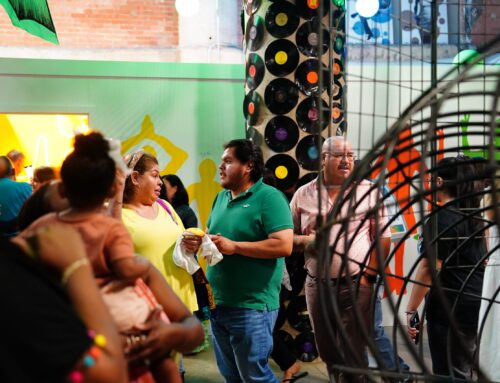Professional artist Diana Goldberg had no idea what she signed on for when she agreed to paint sets for the Woodrow Wilson High School musical production of “Les Miserables” in 2005. Her son, Ian, a freshman that year, had joined the show’s chorus, and another student’s parent had recommended Goldberg for the “job,” remembering that she had painted flats used as backdrops for Jackson Elementary School performances.
Two years and hundreds of hours later, with two completed shows under her belt and another one this month, Goldberg says it has been a huge time and energy-involved volunteer endeavor. And she doesn’t regret one minute of it.
Goldberg and her husband, Brad, are nationally respected installation artists (bradjgoldberg.com) who create works out of massive hunks of stone. It seemed ironic, she says, that most of the painting challenges for “Les Mis” involved developing the appearance of stone surfaces, subject material in which she had immersed herself for 25 years.
In 2006, Goldberg again agreed to be the lead painter for Woodrow’s musical, “City of Angels.” She met with the school’s theater instructor and director John Beaird to discuss the needs of the upcoming production and soon found herself immersed in a dauntingly complex project. It took more than 40 hours of her time every week from February until the show’s performances in April 2006.
Goldberg supervised the creation of 20 massive paintings based on sketches Beaird presented to her, each depicting a different detailed scene from 1940s Hollywood. She led a team of 20 people, mostly other parents and some students, who constructed large flats upon which Goldberg drew each scene in a grid formation. She assigned some of the team to paint in background color while others executed more detailed work. Then Goldberg finished the pieces so that they would “read” well from the audience’s perspective.
It was an arduous task, well beyond her anticipated expectations — and a “superlative artistic accomplishment,” Beaird says.
Why did she do it? For the kids, first and foremost, Goldberg says.
“I feel a responsibility to support these students who work so hard to present a first-class artistic production,” she says, adding that her hard work was also a result of Beaird’s support. “He truly understands the creative process and the value of collaboration.”
She believes Beaird is a huge asset to the teenagers’ educational experience at Woodrow, and that’s why she agreed to continue painting sets for him.
This year, Goldberg’s task is to depict an early 1900s Jewish village, the setting for “Fiddler on the Roof.” She and Beaird agreed on a style reminiscent of world-renowned Russian painters Chagall and Kandinsky. Though it shouldn’t be as time-consuming as last year, Goldberg knows she is committing a huge chunk of her life to the musical.
But last we checked, Goldberg couldn’t wait to start painting again.





